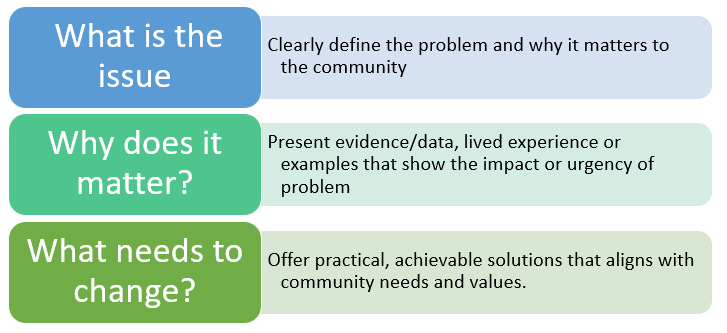Community Advocacy Toolkit
Why is community advocacy important?
Advocacy is the process of working with key decision makers to drive change to benefit the community. It is an important tool used to raise awareness. Successful advocacy relies on establishing strong partnerships and relationships.
Community advocacy plays a vital role in shaping priorities and influencing decisions through grassroots campaigns and local engagement. These efforts ensure that lived experiences and community needs are reflected in the policies and services that impact everyday life.
Who do I advocate to?
Reaching the right people
The first thing to do is to identify the decision makers. This table can be a good way to understand which level of government is responsible for different services:
| Local (Council) | State (Victoria) | Federal (Commonwealth) |
|
|
|
My political representatives
The Victorian Electoral Commission has a useful interactive map to identify who are the relevant State and Local Government representatives for a geographical area - Interactive Map
In Port Phillip, political representatives include:
How do I advocate?
Ways to advocate
Advocacy can take many forms, and creative approaches often make a lasting impression. Connecting with decision makers can take time, so choosing the right tools and channels is important. Below are some ways to advocate for issues that matter to the wider community.
How do I support Council’s advocacy priorities?
Council advocates for funding, policy reform, and improved services on behalf of the community. You can explore current focus areas here: Advocacy priorities
Community support plays a powerful role in amplifying Council’s advocacy. By highlighting shared priorities and adding local voices, it helps build momentum for change. When Council and community advocate together, the message is stronger, more unified, and more likely to influence outcomes.
If you’re passionate about one of Council’s advocacy priorities, you can contribute by using the tools in the Ways to Advocate section of this document.
How do I advocate to Council on an issue important to my community?
Building a case
For items of significance to the whole community, the first step is developing a clear plan. Use these prompts to build a compelling case:

Engage with Council’s budget via the Year 2 Plan
Every year community members and groups can provide input into Council’s annual budget by lodging a submission. In your submission, clearly outline your proposal, explain why it is important for the community, and include any supporting evidence or data.
To find out more about the consultation process visit the have your say site: Plan for Port Phillip | Have Your Say Port Phillip
Write to Councillors
Residents are encouraged to contact their Ward Councillor about issues they wish to advocate for. In your letter or email, clearly state your position, include relevant evidence, and suggest specific actions. Personalising your message can help make it more impactful.
Find out more about who your Councillors are here - Your Councillors
Submit a petition, a joint letter, or a deputation
Residents can submit petitions, joint letters, or deputations to formally raise issues with Council. These are tabled at Council meetings and may lead to further investigation or a formal response.
To find out more, visit - Petitions, Joint Letters and Deputations
Speak at a Council meeting
Members of the public can speak during the 'Public Question Time and Submissions' section of Council meetings. This provides an opportunity to ask questions or comment on agenda items directly to Councillors.
To find out more, visit - Request to speak at a Council Meeting